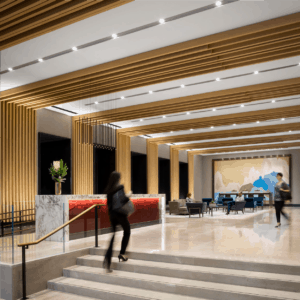by Larry Grossman
Do you remember the last office lobby you visited? Chances are you don’t. For years, office lobby design has traditionally centered on creating a polished, professional space focused on purpose and function.
Fast forward to today where mobile technology allows us to work virtually anywhere, where impromptu, and even planned meetings, can be just as productive in a coffee shop as in a conference room.

Rich textures and tones help office lobbies take a cue from design-driven boutique hotels. / all images by Stantec
- Our flexible workstyles have inspired a new approach to office lobby design. No longer just a place to pass through, savvy building owners are focused on creating a sense of place in their lobbies. Taking a page from the hospitality sector, office lobbies are now being designed as an environment to linger, connect, and recharge. With a goal of establishing a unique sense of identity, my team at Stantec has been focused on designing workplace lobbies that encourage a welcoming sense of hospitality.
Remember the first time you stepped into the lobby of a boutique hotel while on vacation? That sense of welcome, individuality, and attention to detail can now also be found in workplace settings. By utilizing all senses — interesting visual cues, textures, and even scents — a lobby can become a destination all its own.
New office construction in Greater Boston and beyond has created a renewed focus from owners of existing properties to maintain a unique sense of identity and modernity. The office lobby can play an impactful role in the value of a property and its respective neighborhood, especially as tenants view their “office” as extending beyond the walls of their leased space. Occupier lease decisions can be impacted by the quality of shared areas such as the lobby, fitness area, and adjacent outdoor space.
Stantec has repositioned several office lobbies to meet these new demands. Key elements to consider when creating the lobby of the future include:
- Variation. For the repositioning of the lobby at 125 Summer Street, a 22-story commercial building in Downtown Boston, our goal was to create a space that can accommodate a variety of uses. Different types of seating (arm chairs, sofas, and a perch table with stools) configured in diverse arrangements allow for both formal and informal interactions, as well as individual or group sessions.

A striking entry, as at the newly repositioned 125 Summer Street, establishes a neighborhood connection point and maximizes natural light.
- Visual impacts. For all lobby projects, we look to incorporate rich colors and textures through elements like art, furniture, and fixtures to establish a highly curated, personal space. At Lafayette City Center, a mixed-use property in Downtown Boston, we used dynamic light as a central design element. Ribbon-like lights extend along the ceiling to reinforce the path through the lobby to the elevator bank, while creating a bold visual cue from the street.
- Natural light. Daylighting is an essential feature in creating an environment that feels open, inviting, and inspiring. Natural light also supports user wellness and allows us to incorporate other natural features like greenery. At 117 Kendrick Street in Needham, natural light played a starring role in the redesign of the corporate center’s lobbies, interconnecting corridor, and café. Here, we put a focus on the overhead skylights and removed dividing walls to open views and optimize light.
- Hospitality. An extra element to help visitors feel at home in a lobby is the addition of hospitality features such as streaming video or refreshments. I’ve seen a growing number of building owners incorporate coffee bars or beverage stations where occupants can enjoy a drink or pastry while catching up on emails, much like in a hotel.
While lobby redesign is often focused on the interior, it’s also important to build an authentic connection with the area outside a building’s doors. There’s a great opportunity to bring that level of hospitality outdoors as an extension of the lobby through seating, planters, and a welcoming façade. Not to mention, these elements also help better connect a property to a community and help enhance a local streetscape.
Larry Grossman is a senior principal at Stantec.











